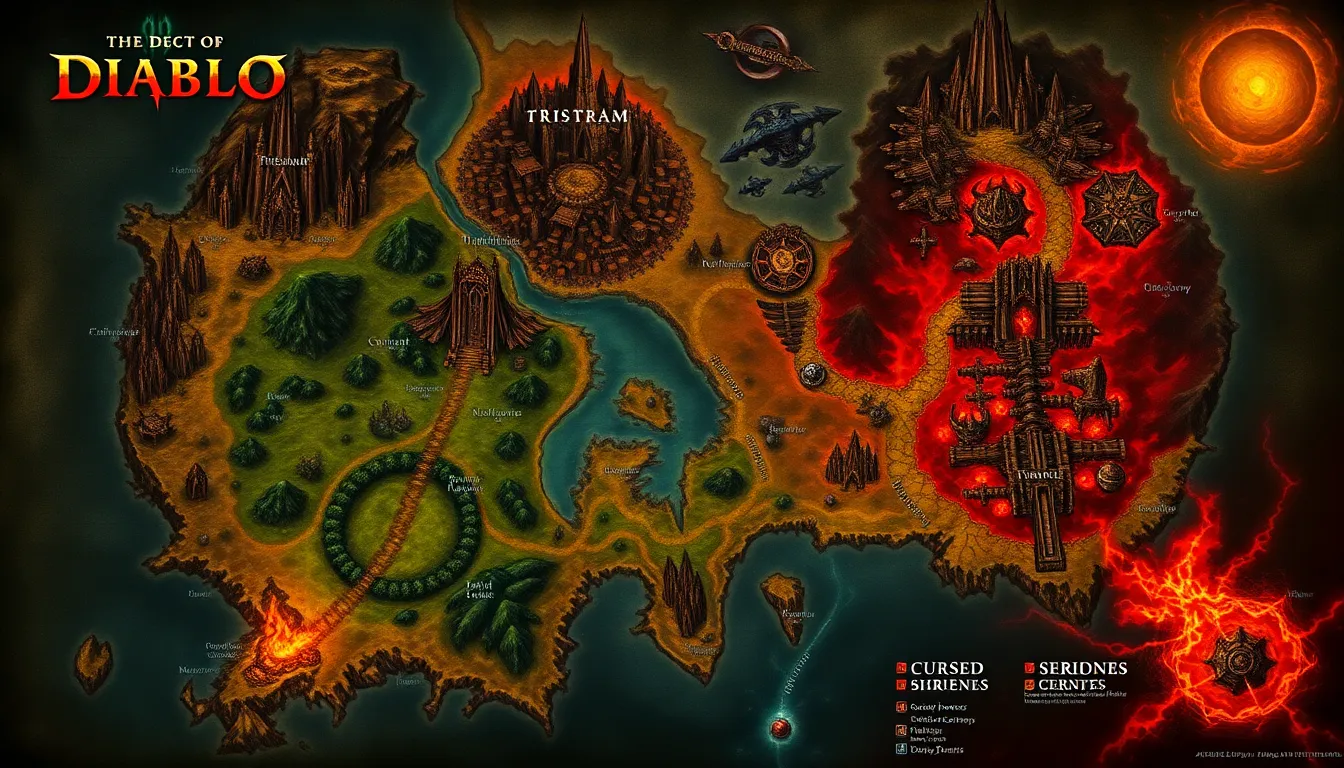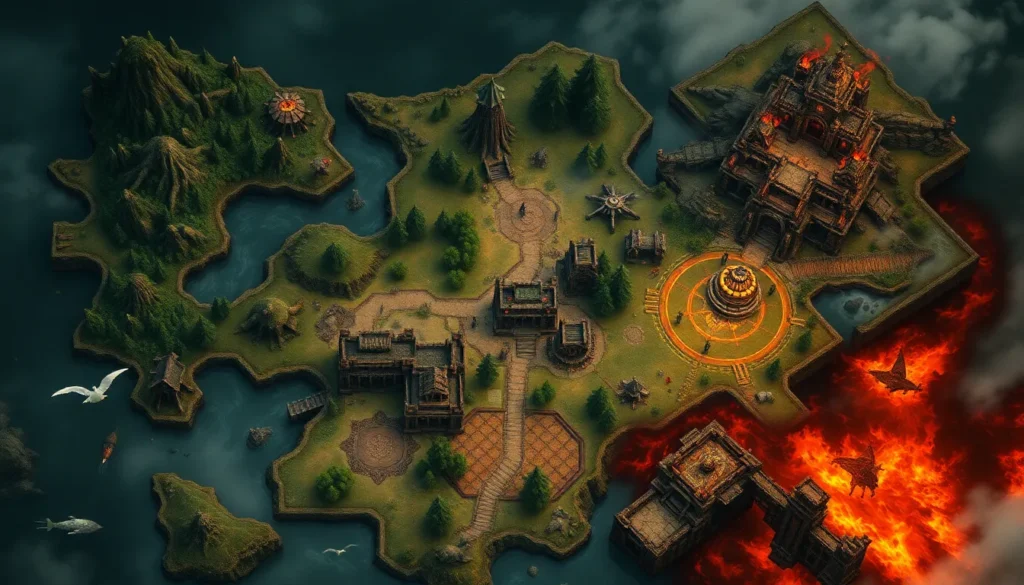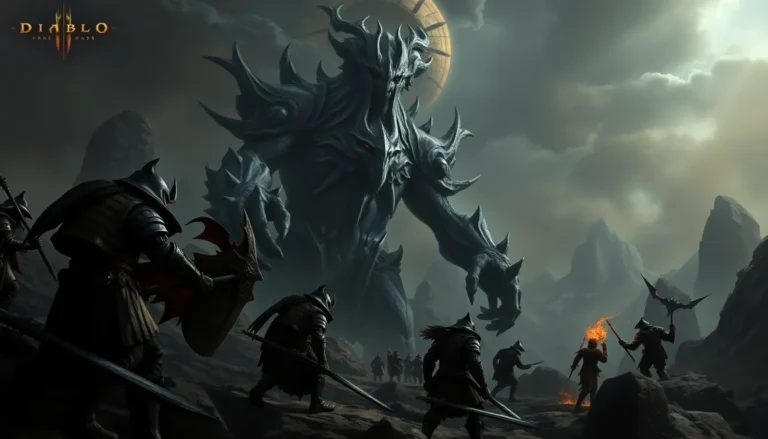Table of Contents
ToggleIn the dark and captivating universe of Diablo, the world map serves as a gateway to adventure, danger, and discovery. Each region teems with unique landscapes, formidable foes, and hidden treasures, inviting players to immerse themselves in a rich narrative that spans centuries. Understanding the intricacies of this world map is crucial for navigating the perils and secrets that lie within.
From the haunting forests of Tristram to the fiery depths of the Hell, every corner of the Diablo world map is meticulously crafted to enhance gameplay. As players delve deeper into this realm, they’ll encounter diverse environments that challenge their strategies and skills. Whether a seasoned warrior or a new adventurer, exploring the Diablo world map promises an exhilarating journey filled with excitement and intrigue.
Overview Of The Diablo World Map
The Diablo world map serves as a crucial tool for players exploring the diverse realms within the game. The map features distinct regions, each with its unique characteristics and challenges. These regions include:
- Tristram: Known for its cursed history, Tristram presents eerie forests and treacherous foes.
- The Wilderness: A vast expanse filled with dangerous creatures and hidden pathways, inviting exploration.
- The Horadric Temple: Contains ancient secrets protected by powerful guardians, requiring strategic navigation.
- Hell: The infernal domain where players face formidable enemies, characterized by a fiery and hostile landscape.
Understanding the layout of these areas enhances navigation and survival, enabling players to uncover hidden treasures. Key points of interest such as shrines, dungeons, and waypoints also populate the map, providing strategic advantages. Knowledge of the terrain allows players to prepare for confrontations and optimize their strategies effectively. The Diablo world map is not just a guide; it’s an essential component of the immersive experience, enriching gameplay and adventure.
Key Features Of The Diablo World Map

The Diablo world map features several key aspects that enhance gameplay and exploration. Understanding these features allows players to navigate through its complex environments effectively.
Major Regions
- Tristram: Known for its cursed history; players encounter an atmosphere filled with despair and haunting creatures. The original town from Diablo I remains pivotal, serving as a nostalgic center for players.
- The Wilderness: A vast expanse of untamed terrain; populated with fierce monsters and challenges. This region tests players’ skills as they confront threats hidden within dense foliage and treacherous paths.
- The Horadric Temple: A significant location; this ancient temple houses secrets and valuable lore. Players navigate puzzles and battle foes while uncovering the history of the Horadrim.
- Hell: A hostile landscape; marked by searing landscapes and ruthless enemies. This final region presents the ultimate challenge, demanding high levels of strategy and skill from players.
Unique Locations
- Cursed Shrines: Scattered throughout the map; these shrines offer buffs but demand sacrifices in return. Players must assess risks versus rewards when activating these locations.
- Hidden Boss Lairs: Often concealed in various regions; these lairs feature powerful enemies that guard unique loot. Discovering these locations can lead to significant advantages.
- Dungeons: Numerous dungeons litter the Diablo map; each containing its distinct challenges and treasures. Players strategize their approaches to maximize their chances of success.
- Artifacts and Relics: Unique items found in specific regions; offer powerful enhancements. Players recognize the importance of searching thoroughly for these game-changing artifacts.
Exploration Tips For The Diablo World Map
Exploring the Diablo world map requires keen observation and strategy. Players benefit from understanding terrain and uncovering hidden areas that enhance gameplay.
Navigating The Terrain
Navigating the terrain involves recognizing key landmarks and utilizing the map’s layout. Players should:
- Study the Map: Review regional details for insights into landscapes and enemy types.
- Use Landmarks: Identify significant landmarks like towns or dungeons as reference points.
- Monitor Environment Changes: Pay attention to environmental shifts that indicate nearby dangers or treasures.
- Be Aware of Pathways: Familiarize with paths and shortcuts that facilitate faster travel, especially in high-danger areas.
Effective terrain navigation prevents surprises and ensures players can respond to threats swiftly.
Finding Hidden Areas
Finding hidden areas enhances the gaming experience with additional treasures and challenges. Players can:
- Explore Off the Beaten Path: Venture into unexplored regions where elusive treasures or quests might lie.
- Check for Interactable Objects: Look for unusual or interactive objects that may lead to secret locations.
- Engage with NPCs: Talk to non-playable characters who may provide hints regarding hidden spots or special quests.
- Use Ability Combinations: Leverage character abilities to access hard-to-reach areas or trigger hidden events.
These strategies maximize exploration rewards and enrich the overall journey through Diablo’s world.
Impact On Gameplay
The Diablo world map significantly influences gameplay by shaping players’ experiences through exploration and strategic planning. Understanding its layout enhances quest completion and player tactics.
Influence On Quests
Quests in Diablo frequently intertwine with the world map, directing players to specific locations for objectives. Each region reveals unique quests, often tied to the lore of that area. For example, Tristram features quests that explore its cursed history, while the Wilderness presents survival challenges against dangerous foes. Players encounter various types of quests, including main story arcs, side missions, and hidden objectives, which often require navigating treacherous environments. Successfully completing these quests not only advances the storyline but also rewards players with valuable items and experience points, essential for character progression.
Role In Player Strategy
Player strategy heavily relies on the world map’s features and terrain. Knowledge of regional enemies, environmental hazards, and treasure locations enables players to prepare effectively. For instance, understanding the layout of the Horadric Temple aids in anticipating enemy encounters and planning combat tactics. Additionally, players employ terrain advantages, using high ground or narrow passages to manage threats. Strategies also include utilizing shortcuts uncovered on the map to save time and resource expenditure. Utilizing artifacts and relics located throughout the map further enhances player capabilities, enabling customized strategies tailored to different scenarios. Overall, the map serves as a vital tool that enhances strategic decision-making and enriches the immersive gaming experience.
The Diablo world map serves as an essential guide for players embarking on their epic journeys. Its diverse regions offer a mix of challenges and rewards that enrich the gameplay experience. By mastering the map’s layout and features, players can uncover hidden treasures and strategically prepare for encounters with formidable foes.
Exploring the intricacies of each area enhances not only navigation but also the overall immersion in Diablo’s dark and captivating lore. With the right strategies and insights, players can turn the map into a powerful ally, ensuring that every adventure is filled with excitement and discovery. Whether a seasoned veteran or a newcomer, understanding the world map is key to unlocking the full potential of the Diablo experience.




